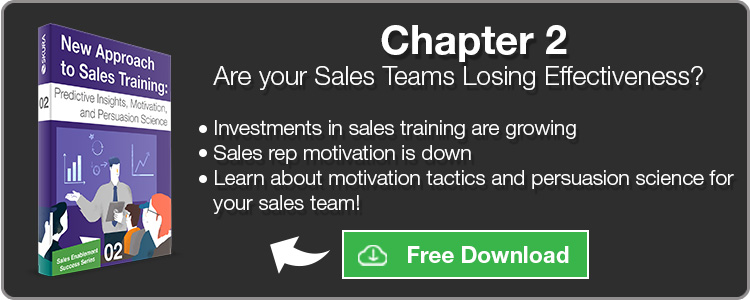Digital content marketing often includes the creation of digital content sales material such as case studies, ROI outlines, product spec sheets, financial charts, compliance paperwork. 3D schematics, and etc. which may support a variety of sales interactions throughout a buyer’s decision journey.
Unfortunately these investments tend to miss the mark on usefulness for sales reps and managers, and often add friction to the sales process.
Today we answer the quesion of what sales reps need for strong adoption of digital content sales material.
This article continues an earlier discussion about why sales doesn’t use digital content created for them.
When it comes to sales content, although adoption and usage are low, there are only a few things sales reps actually need from their content in order to make full use of it.
Digital Content that Actually Applies to the End of the Sales Funnel
It should go without saying, but if you want your sales reps to use digital sales content across their sales process, you need to create content that actually applies to the sales process after a handoff from sales to marketing.
In our last article we revealed that sales reps and customers near the end of the sales funnel share similar concerns with the content that is created for them. Our own study into sales content revealed that most find content effective for lead generation, but very poor for closing when marketing teams don’t include sales insights into content creation.
Sales reps often create their own content as a result of this mismatch, and the content that they create tends to be used much more than content created by marketing.

(Image Source: CMS Newswire, 2016)
There are two ways to create content that the sales team will want to use across their sales process.
1) Use end-to-end digital content analytics integrated with CRM
Marketing teams already use marketing automation software that captures consumption metrics during lead generation, and they use this knowledge to optimize content for lead generation. This explains why most find marketing content effective for lead generation but not for closing.
The easiest way to get marketing teams to optimize digital content for closing is to push end-of-funnel consumption metrics into CRM and marketing automation. This is one of the most common predictive analytics challenges with content, as few are applying the right metrics to their content for end-to-end content effectiveness.
2) Make Sales and Marketing Alignment a Top Priority
Sales and marketing alignment is all about communication and breaking down organizational silos. Marketing tends to facilitate a one-way information and traffic flow for content, which impedes effective content creation. As few as 1 in 7 marketing teams include sales in the creation of customer facing content, and breaking down this silo should be a top priority for addressing content challenges.
Content Management 2.0
It isn’t enough to just say that we need to revitalize digital content management strategies. Sales content needs to be impulse consumable. At Skura we believe that sales teams need to focus on building relationships and selling. This doesn’t happen when sales reps are searching for content and creating their own.
68% of organizations store their content across 5 or more storage repositories:

(Image Source: CMS Newswire, 2016)
These repositories tend to be on platforms that make finding the right content a chance driven ordeal at best. Furthermore, each employee stores an average of 273 files, meaning that a company of 10,000 people juggles 2.73 million digital files at any one time (Source: CMS Newswire, 2016).
The sales team needs more than just content management. Consider these statements about content marketing from sales reps and sales managers:
- Better inform me when we release new content;
- 46% of sales reps and managers.
- Help me understand how our content relates to our customers;
- 37% of sales reps and 47% of managers.
- Help me better understand how to use thought provoking content to prospect;
- 39% of sales reps and 51% of managers.
- Help me understand how to use thought provoking content to close deals;
- 39% of sales reps and 40% of managers.
- Help me understand how to use thought provoking content to grow key accounts;
- 35% of sales reps and 48% of managers (Source: Richardson, 2013).
In order to address these needs, a sales team needs a content management system that sorts and organizes content by persona; with intelligent content recommendations for the buyer in question; and automated CRM updating to ensure a real time 360 degree view of the customer.
At Skura we call this content management done like Netflix. Unfortunately, many organizations are investing in deeper levels of sales training in order to address digital content marketing challenges among sales reps, when in fact, more sales training later in the life of a sales rep does little to impact this kind of effectiveness.
Real Time Actionable Information about the Buyer
We have a gap along the decision journey for many B2B companies. Buyer awareness is highest during lead generation, but once an MQL is passed to the sales team, buyer awareness deterioritates. The real-time CRM updates from marketing automation become anecdotal inputs by the sales team after the handoff.
Once you consider the adoption challenges plaguing many CRM implementations, the size of this gap becomes clearer.
The problem here isn’t CRM, it’s the sales stack supporting your digital sales endeavors. The sales stack industry is ballooning, which is creating some unique challenges around understanding and selecting the best tools among a fragmented menu of options.
As we’ve found, an effective sales stack only consists of 5 core components, one of which is CRM. The rest of your sales stack helps automate some of the most time consuming and error prone processes of your sales funnel for effective sales enablement.
Your sales stack needs to place customer information front and center so that your sales reps aren’t spending time searching through CRM for details which may not even be there. Furthermore, the sales stack is meant to return selling time back to sales, if this isn’t being achieved, you have a gap in your sales stack.
Is your content sitting unused? Do sellers struggle to find what they need? Is your sales stack adding friction to the sales process? Request a demo and let us show you what impulse consumable, automated, and informed digital sales can feel like.
Why Shouldn’t Sales be Creating Content?
Earlier in the article we revealed that content created by sales gets used by sales, but this is in fact a huge problem that needs to be addressed. In our next article we’ll explore the deep seeded issue of content that is created by the sales team.
Subscribe to our mailing list for an automatic update on release. A hyperlink will be added here to that article.













